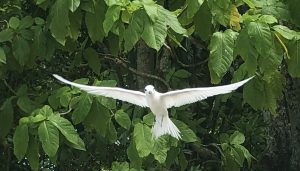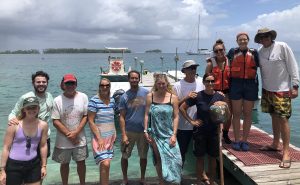Palmyra Atoll is a jewel on so many fronts. We had to get permission to call in, and that involved pest inspections and a hull check (for invasive species of weed and barnacles etc) but when you get there you completely understand why it is protected and needs to be so.
The teams there from The Nature Conservancy and US Fish and Wildlife Service (USFWS) work together seamlessly and with passion to eradicate invasive species, protect the native inhabitants and to support and build resilience back into the ecosystem. They provide a base for several research establishments (universities and oceanographic institutes) to study the atoll and surrounding ocean. As well as the official representatives of the two organisations, they are supplemented by a cheerful, hardworking team of volunteers, the so called “coconut killers”, there to remove the majority of the coconut palm monoculture – the coconut is an introduced species which doesn’t support the native ecosystem. Removal is hard graft: chopping the small sprouts with machetes and dealing with the bigger trees and the teams work long days and 6 day weeks, respect to them for their zeal and enthusiasm.
Sand Island is one area USFWS has been successful in the coconut removal venture. The difference is extraordinary. The number of breeding bird species and crab species that a proper, diverse native tree culture can support is multiples of that a coconut forest can.

There has also been a successful atoll wide rat eradication program, and the results are clear, even around the camp, with something like 10 different crab species thriving and expanding.
We have many other wonderful, inspiring memories. Ask Dani and Pritch about their twilight experience sitting in a curve of the dock near the main base as two manta rays circled in close, sometimes touching them, attracted to the plankton, in turn attracted by a light shining into the water at the jetty’s edge. Magical.
Check out YouTube for some phenomenal videos of Palmyra and you will have a small glimpse of what we have seen and of the vital work the two teams are achieving.
Enormous thanks in particular to Carly from the Nature Conservancy and Stefan from USFWS – we owe you a great debt for your hospitality and for your herculean efforts as guardians of Palmyra. The world is going to need these oases of natural variation and species breeding grounds if it is to prevent the oceans becoming deserts. If you can find ways to support their efforts (and prevent their resources being cut and redirected) please, get stuck in.



